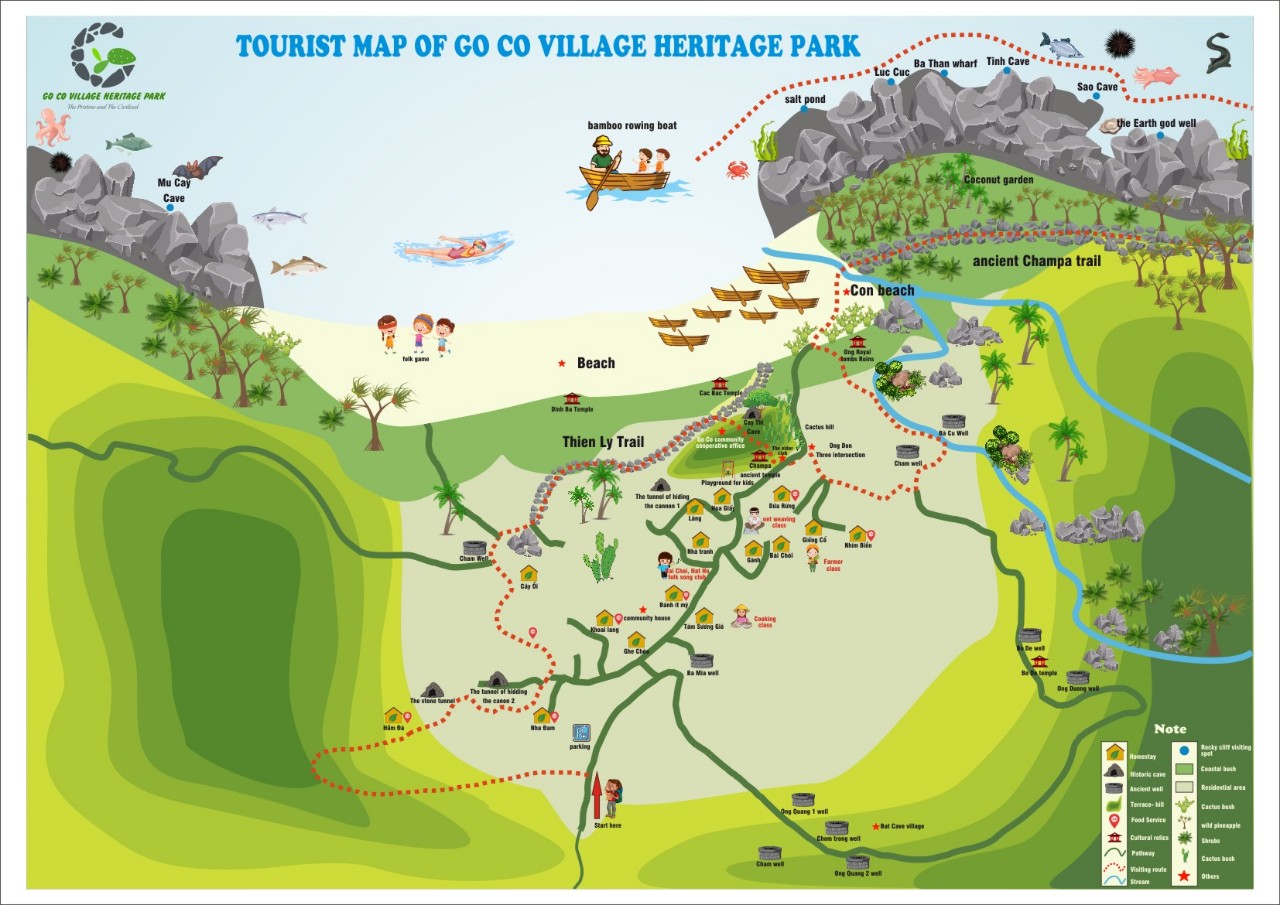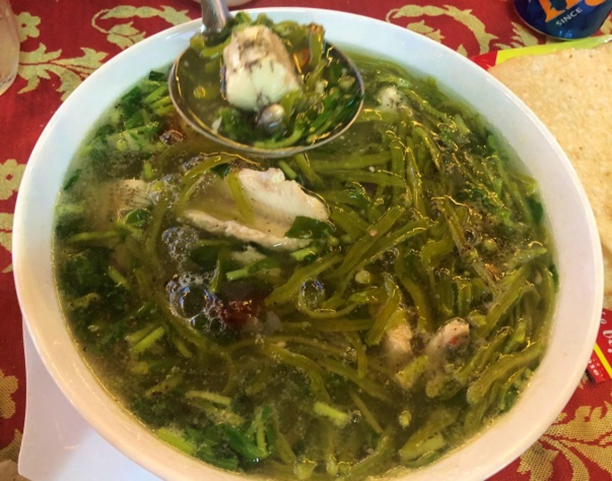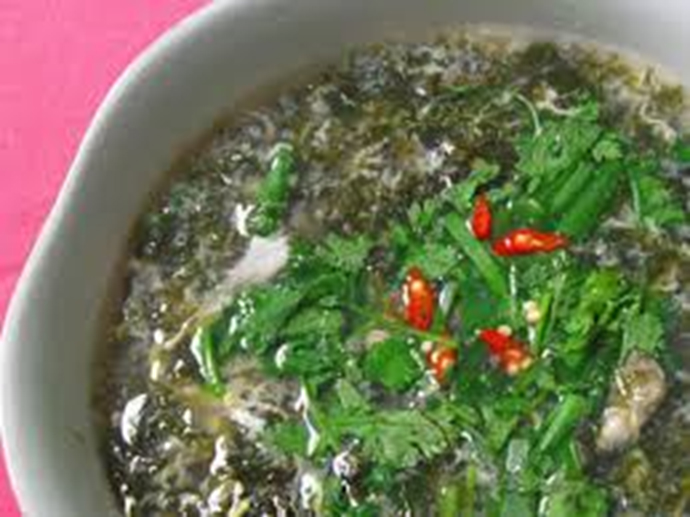Go Co Village Heritage Park travel guide
If you are looking for a space to slow down, take a break from the bustle of the city to find nature, with a peaceful rural life, find the true values of life and Satisfying your desire to learn about culture and history for thousands of generations, Go Co is the place for you. Located in the center of Sa Huynh cultural space in Pho Thanh commune, Duc Pho district, about 60 km south of Quang Ngai city, Go Co is a coastal village that still retains its rustic house folds. idyllic, stone cliff hundreds of millions of years, pristine nature and the remains of the Cham Pa period. Not only that, this is also a village rich in revolutionary tradition with resilient people holding the village during two fierce wars of the 20th century. With the values of landscape, geology, and literature History and valuable assets from the gold and silver forest and the rich spiritual life of the indigenous community, Go Co village deserves to be an attractive destination in Ly Son – Sa Huynh Geopark. The village is now transformed into a new shirt called Village Park because it fully integrates the values of a miniature geopark on the scale of a village. The article below will provide you with the necessary information for your journey to discover Go Co Village Heritage Park.
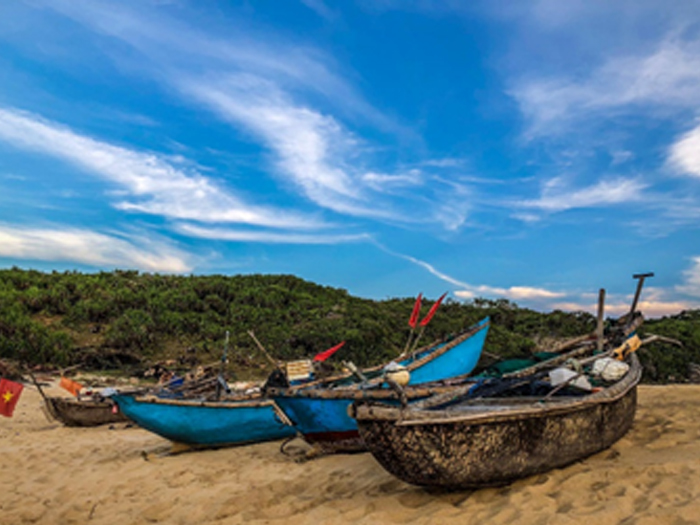
Bamboo boat on Go Co beach
1. Schedule a trip to Go Co?
The climate in Go Co is divided into two distinct seasons due to the influence of the northeast and southwest monsoons. The dry season (summer) starts from around April to the beginning of September. This season is almost dry, the sea is calm, clear, and sunny. This is also the best time to travel to Go Co. During the peak of the sunny season around June & July, the weather is strong in the afternoon and afternoon, so visitors to the village need to bring a sun jacket, hat, water bottle and sunscreen. (Note: The sea in April & May is still cold, but it’s already sunny, so you might consider going to the beach). This season, if you plan to catch the sunrise on the sea in Go Co, you should be there before 05.20am and in the afternoon to watch the best sunset, it is around 6am.
The rainy season (winter) lasts from October to February. This season can have big storms with cold and rough seas. However, due to its location on a high hill, the area’s morphology is like a basin covered by surrounding hills and mountains, so Go Co is also less affected by storms and floods. In March there was no rain, the weather was pleasant and cool, but the sea was still rough, not suitable for swimming.
Note: You should spend at least 2 days to be able to check-in all the attractions in the village area. If you have more time, you can spend 4-5 days in Go Co to feel the best of daily life with the local people.
2. Vehicle to Go Co?
Go Co village heritage park is located in the Sa Huynh land strip, according to the long-standing name of locals, so when you ask for directions to Go Co, you should mention Sa Huynh, local people will easily imagine to show directions. give you more. Vehicles to get to Go Co include:
Airplane
If you want to save time, the plane will be the optimal choice for travelers. You can fly Hanoi / Ho Chi Minh - Chu Lai route of Vietjet and Vietnam Airline and travel from Chu Lai airport to Quang Ngai city about 50km away. Then, you take bus No. 2 of Quang Ngai city to Sa Huynh for about 1 hour. Getting the bus is quite convenient with fares ranging from 7,000 VND - 24,000 VND.
Passenger car
The bus is also a very convenient way to get to Go Co. If tourists departing from the North, you can choose the car parks such as Hoang Long, Sao Vang, Chin Nghia, Phuong Trang with fares ranging from 350,000 to 400,000 VND / person. If tourists departing from the South, they can go to the East bus station to buy tickets to Sa Huynh, Quang Ngai from companies such as Chin Nghia, Phuong Trang, Tuan Tu, Rang Dong, ... in which Chin Nghia is a popular car company. the largest in Quang Ngai. Fares also fluctuate similarly from the North. Tourists got on the bus from the previous afternoon and only slept for one night, and the next morning, they arrived at Go Co village - Sa Huynh.
Airplane
When you come to Sa Huynh (Pho Thanh commune), you will choose to stop at the 'mango tree' junction '' (Long Thanh I village) on the national highway and take a motorbike taxi into the village just about 5 minutes. For the group of tourists taking cars from 7-35 seats can run straight from the junction into the village and park at the first stop of the village. If you walk from outside the intersection, you can go straight to the preschool point of Pho Thanh ward, turn in the direction of the arrow indicating Sa Huynh Culture Gallery and ask the people for directions to Go Co village. The walk from outside will take about 15 minutes.
Motorcycle
For those who love to travel long distances, riding a motorbike to Go Co village is also an interesting experience. However, with a small area and also to keep a quiet, smog-free space for the village, Go Co is suitable for walking in the village, so you should only stop at the parking lot village head.
Phone numbers to know
Go Co Village Community Tourism Cooperative Office: 0255 6288 111 / 0935155239/ 0979 718 024
(to book a service)
Security Department of Long Thanh 2 residental group: 0905 475099
The leader of Long Thanh 2 residental group: 039 8312944
3. Visit what in Go Co village?
Located on a journey to the south of the Ly Son – Sa Huynh geopark, Go Co is the land of ancient cultures, hundreds of millions of years old, and simple rustic people. industrious, resourceful, resilient to the challenges of harsh nature and fierce war. This place witnessed the continuation of the three Sa Huynh cultures (about 2000-3000 years ago), then the Cham Pa (from the seventh century – the fifteenth century) and then the Dai Viet until the date. Archeology and history experts have confirmed the evolution of these cultures through the relics discovered in the Go Co area and some surrounding areas.
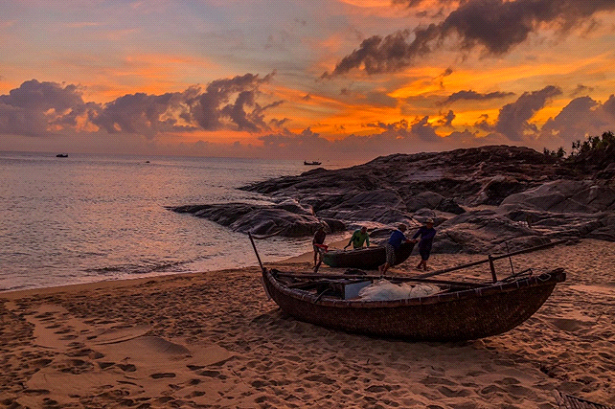
Fishermen set sail early on Go Co sea
Stone works – Traces of the existence of the Cham Pa
Go to Go Co, you can easily see rocks everywhere in the village. Stone is the material to form works associated with people’s daily life such as fence, old well, stream bank, ancient stone road. These works, along with many other remnants of stone left over the Sa Huynh strip such as stele, stone bridge, square Cham well … are proof of the existence of the Cham Pa people, the class of people who lived on The land of Sa Huynh before the Vietnamese emigrated
Neck well
At present, there still exist 12 ancient wells which are scattered within the park of Go Co village. The common feature of the wells is that the well wall is made up of naturally layered granite, which fits closely, without the need for cutting or using cement. The well was built on hard rock, on the mouths of underground waterways and beside small streams that flow from the high mound. Of the 12 ancient wells, some were formed from the period when the Cham people lived in the village (from the 7th to the 15th centuries). Before the ancestors of the Go Co people came to live in the village, they saw the existence of these wells, which are wells: Mrs. Thieu well (located in the lower neighborhood, next to bamboo bushes), wells of Mrs. Mia. (near Mrs. Toan’s house), Ong Lich well. Wells are named after the owner of the land in which the well is located. The well mouth has been cemented by people to create the safety of children in the nearby area. The rest are wells dug by the Vietnamese and inherited the Cham well architecture, ie stratified rock architecture with well positions in the underground water. There are some beautiful wells such as Mr. Duong well, Ong Quang well, Bo De well, Ong Lien well, Mr. Tich well, …
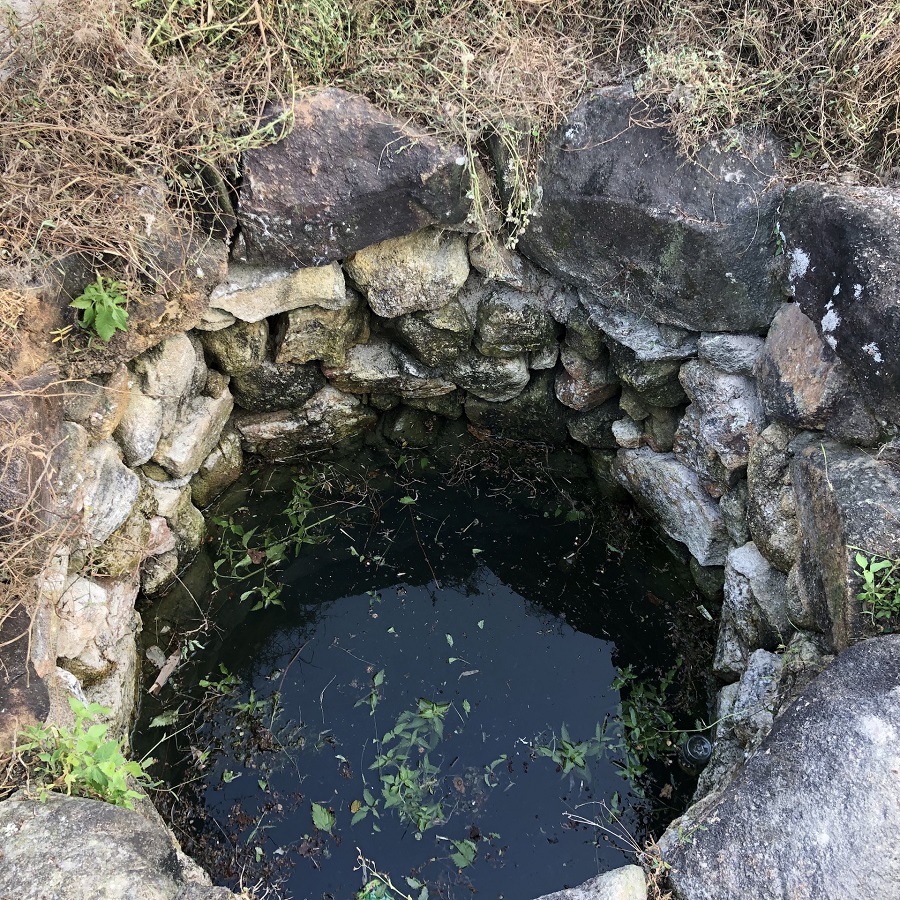
See details about ancient wells here.
Cave, rock shelter – A fierce past of war bombs
The Go Co village heritage park is beautiful because of its wilderness and tranquility, but it’s hard to believe that this place was once destroyed by bombs and bombs during the war. Memories of war are still evident in the accounts of each Go Co and exist in the remaining stone caves and bunkers in the village. First of all, the stone cellar in Mrs. Chin’s house, the owner of the homestay Ham Da. She is over 80 years old this year, the mother of martyrs. If you meet her at home, do not hesitate to visit her house, visit the stone cellar and listen to her stories of the war years in the village. In addition to the stone cellar of Mrs. Chin’s house, there are other stone vaults around the village such as Artillery Tunnel No. 1 & 2, Thi Tree Cave. The cannon shelters are natural stone tunnels, with narrow mouths, about 1-3m deep, accommodating 15-20 people, all of which are places to protect and shelter for families when the village is bombed by bombs.

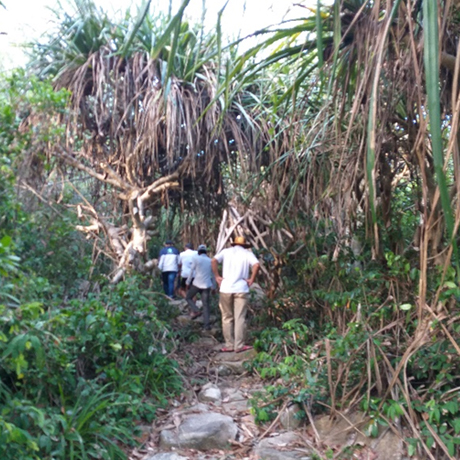
Ancient Cham stone road
Many generations of Go Co have passed on to their children and grandchildren that this is an ancient stone road formed in the period of the Cham Pa people. The road starts from the Xom above of Go Co village, connects to Thanh Duc 1 village beach, where the Cham Pa inscription is thousands of years old. Walking on this road on summer days, you will see a lively space of nature with a variety of bushes, such as pineapple, date, pompano, guava, acorn, interspersed with birds, summer cicadas.
Note: In summer, if you plan to explore the ancient Cham stone road, you should depart early in the morning or in the cool afternoon for the best experience.
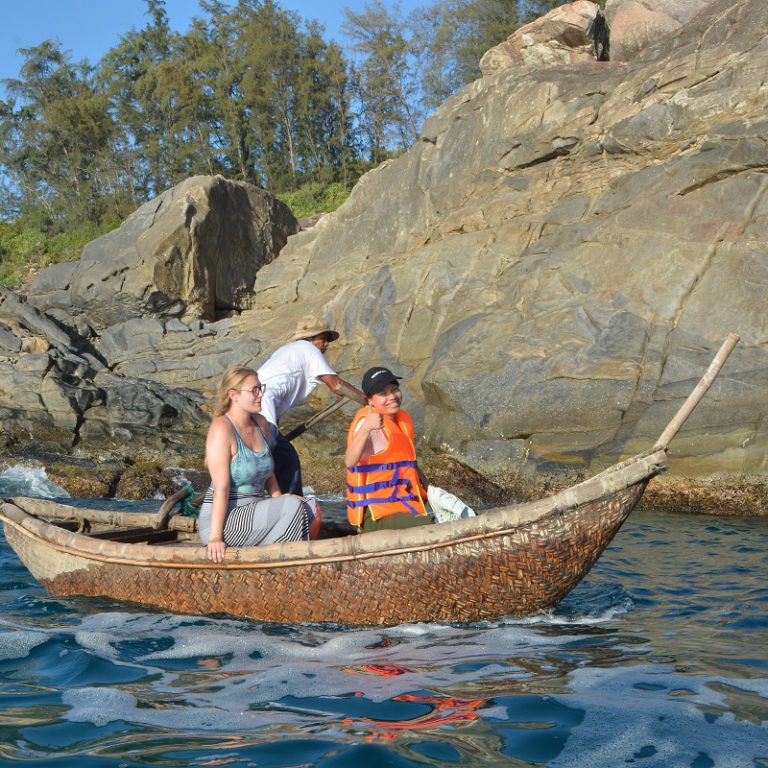
Hang Doi village (uninhabited village, or ghost village) – A past of the house
Hang Doi village is actually a part of Go Co village (one of the four hamlets, called inner hamlet). The village is named after the local Go Co because there is a bat cave in the village. Going from the parking stop at the top of the village, about 20 meters ahead you will see a path leading up to Hang Doi village. People in the village left because of poverty, because of war, leaving dilapidated houses, deserted, a little mysterious, a little compassion. The objects in the house still seem to be kept intact, from the bed, the mirror, the comb, the dining table, making one can feel an old style.
Stone Cliff – Nature’s masterpiece, home to marine life
Attached to the beach is a stone cliff 250-400 million years old (at the same time dinosaurs existed). The process of volcanic formation, natural weathering and other impacts of waves have created rocks with all kinds of colors and shapes. Waking up early to go to the rapids at dawn is also an interesting experience. If you pay close attention, visitors will discover rocks shaped like elephants, warriors, egg-shaped rocks, … along with trees growing in the rocks such as maple, sea spinach, pineapple, tiger’s tongue … Not only is the home of many types of seafood such as sea urchin, oyster, crab, snail, squid, fish, and stone cliffs is also a shelter for villagers during the war years. Walking along the cliffs, you will discover many natural caves associated with the stories of Go Co village such as Vung Salt, Egg-shaped stone beach, Ben Ba Than, Gieng Ong De, Dau Choi, …
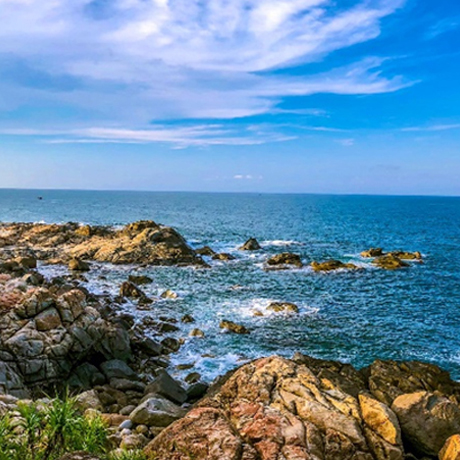
To see the beauty of the rock in the most wonderful way, you should choose the rafting experience at dawn or sunset. This is one of the community services at Go Co Village Heritage Park, discussed and developed by the fishermen themselves – members of the Go Co Village Community Tourism Cooperative. The fishermen will take you on your own traditional bamboo boat to see the rock for hundreds of millions of years. The fishermen will tell you stories about natural rock caves in the rapids – a safe haven for the people of Go Co village during the war years. In addition, you can go out to sea with the fishermen to experience netting at about 3 am, then board a boat to watch the rapids and return to the village by trekking through the coastal hills. You can contact the office of Go Co village community tourism cooperative or information on the website to book or consult about this experience tour service.
Cost for the bamboo boat experience: 100,000 VND / 1 person (including departure and return). For detailed cost reference, please click here.
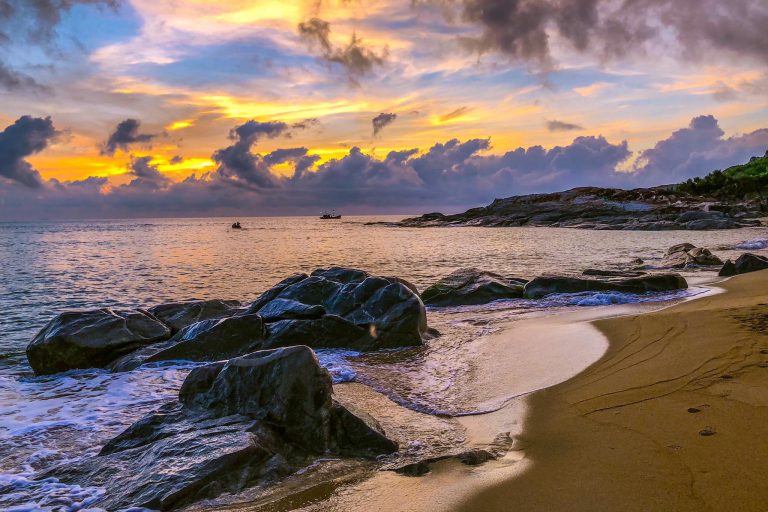
Beach
Standing down from above, Go Co beach is like a highlight that brightens up the picture of Go Co village. For those who are passionate about exploring the countryside still retain their ancient and peaceful features, they will surely be surprised by the beautiful deep blue coastline that is both gentle and wild of Go Co village.
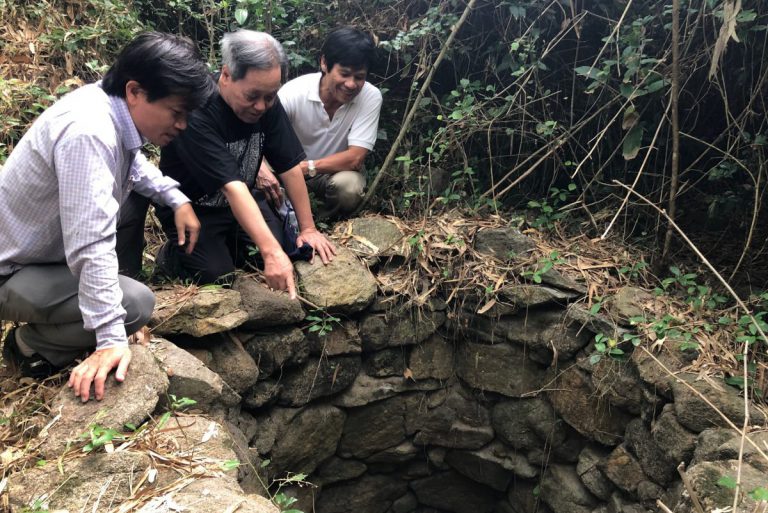
Ancient Well
Ancient wells can be considered as works to keep cultural and historical marks of Go Co village for thousands of years. Of the 12 old wells present in Go Co village, there are 3 wells (Ba Thang well, Madam Mia well, Mr. Lich well) which are ancient stone wells, a feature that shows the existence of the Cham Pa class
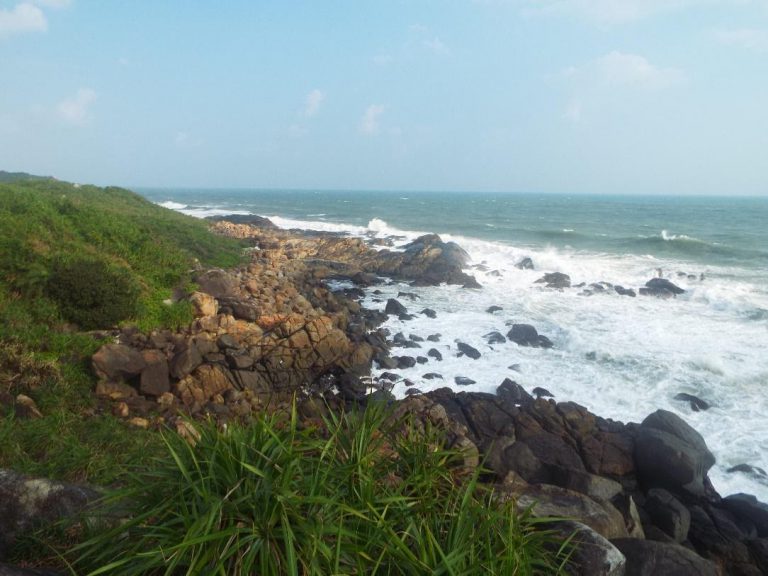
Go Co rocky beach
Go Co rocky beach is a highlight not to be missed in your journey to discover in Go Co village. That is the result of natural weathering process, fracture activities, volcanic eruptions, creating rocks of different colors with all kinds of interesting shapes dating back 250-400 million years (together dino era).

Bai Choi and Hat Ho folk song Club
Bai Choi is a typical folk art and folk game in central Vietnam. On December 7, 2017, Vietnam’s Central Bai Choi Art was recognized as the representative intangible cultural heritage of humanity. The Bai Hut art scope includes 11 central provinces and cities from Quang Binh to Binh Thuan (excluding the Central Highlands provinces)
4. What to study at Go Co?
In addition to the natural elements of landscape, geology and the existence marks of strong cultural acculturation, Go Co village also attracts tourists by the rich spiritual life of the people shown through activities. Lively fishermen – parallel farming existed for generations, through the singing of the rustic hut and typical dishes made from raw materials of the sea and local forests. Go Co Village Community School is a program that helps participants best experience traditional skills and activities associated with the livelihoods, culture and history of the Go Co people. In particular, the “lesson plan” of the class will be built by the people themselves and at the same time, people will directly guide visitors to implement the classroom activities. At present, Go Co village community school includes cooking classes, weaving nets, farming and folk games. The program is suitable for student / student unions because this is an opportunity for them to experience the skills associated with the livelihoods and culture of the community in practice. In addition, visitors can also register for these classes to experience cultural experiences with local people.
The cost of joining classes at Go Co Village Community School ranges from 25,000 – 70,000 VND. For price details, you can refer here.
 The students learned to cast banh xeo at the class of Go Co Village Community School
The students learned to cast banh xeo at the class of Go Co Village Community School
5. Where to go to in Go Co?
Currently, to Go Co, you can choose to stay at the homestay. 15 homestays with impressive names about the characteristics of each house will urge you to find the answer from the owner. The architecture and layout in the house as well as the living furniture are mostly kept intact, rustic and traditional so you can feel the culture of a house in Go Co over generations. . Do not hesitate to roll up your sleeves and join the hostesses to participate in cooking a meal or help them with their daily activities. They will tell you a lot of interesting stories about the cuisine, culture, history, livelihoods on the land where their fathers lived. To refer to the services, price list at the homestay as well as to book a room, you can click on the Service section or contact directly the phone number of the Go Co Village Community Tourism Cooperative. If you come directly to the village, you can refer to the service prices listed at each homestay.

Paper flower Homestay
Note: Most of the homestays do not have air conditioning and only use fans. You need to prepare your own personal belongings while staying at the homestay.
The cost of staying at a homestay ranges from 60,000 – 90,000 VND / person / 1 night. For pricing details, please click here.
What to eat at the Go Co?
Currently, homestays and community restaurants provide food and beverage services. The raw materials are mostly taken from local products such as tubers: sweet potatoes, refined rice, turmeric, tapioca … or from the nature of the sea and Go Co forest. The village’s cuisine can be divided into four main groups: Dragon’s tongue, seafood, tubers, and wild vegetables.
Dragon tongue is a species that grows naturally in Go Co in particular as well as in Quang Ngai or Quang Nam, Binh Dinh in general, this can be considered as native plant of Go Co. In addition to planting dragon tongue as a fence around the house, people also use dragon tongue as a food to process folk dishes such as dragon tongue soup, shrimp tongue soup, in addition to tongue jam. long, a new dish that has been processed by people recently.
Seafood in Go Co sea is plentiful and diverse in four seasons. The people of Go Co are also skillful in creating delicious, nutritious dishes that are both nutritious and fresh for the freshness of seafood. Some certain dishes you must try such as: egg mum, oyster egg rolls, anchovies, squid, oyster leaf soup, jam-leaf soup (only in winter)…
The harsh weather seems to make it difficult to grow any kind of tree, but the typical sandy soil type in Go Co is perfect for growing tubers. When visiting Go Co, definitely, you must try some dishes made from tubers such as: dried sweet potato rice, bread with little cassava, sweet potato mixed with coconut, … or buy as gifts like turmeric powder My starch …
The vegetation in the hills around Go Co is the place to supply some vegetables that are raw materials to process some typical dishes of Go Co such as boiled spring vegetables, boiled turmeric flower, raw chicken, and sour soup.
In addition, you should also try some desserts such as: ginseng dew tea, aloe vera tea, water float tea, a little bread, forest pineapple juice, seaweed water,…
See more details on menu prices here.
- In the itinerary to explore Go Co Village Heritage Park, if you have time, you can visit some more surrounding points such as:
- Sa Huynh culture gallery, An Khe lagoon in Cat hamlet, about 5 minutes by motorbike or 15 minutes walk from Go Co Village Heritage Park. Archaeological relics of the ancient Sa Huynh people 3,000 years ago discovered in An Khe lagoon were partially displayed at the Sa Huynh culture gallery.

Sa Huynh culture gallery
Long Thanh I Market (morning meeting from about 5am) is about 10 minutes walk from Go Co
Sa Huynh Market, the big market of Sa Huynh area is located on the national highway, 15 minutes by motorbike from Go Co
Vung Bang Beach (belonging to Thanh Duc I residential group, Pho Thanh ward), where there is a Cham inscription with 10 lines of Sanskrit words that have not been decoded. You can follow the ancient Cham Pa stone road from Go Co village about 20 minutes walk or 15 minutes by motorbike
Hoc Mo beach is about 3 km away from Go Co
Chau Me Beach is about 10 km away from Go Co. Especially, if you need to eat delicious and cheap seafood, you can visit the seafood restaurants here
Hang Yen is about 16 km from Go Co
Dong Van village, the only mountainous village of Pho Thanh ward, retains its pristine features such as terraced fields, streams, fields, mountains and forests…

People are making pottery with turntables
- Pho Khanh Pottery Village, where there are craft villages of Sa Huynh pottery
You can refer to some tour schedule suggestions here.
Note: In the Go Co Village Heritage Park area, homestay accommodation is only available. In addition, you can choose to stay at hotels and motels in Sa Huynh, about 15 minutes by motorbike ride along the national highway to the south.
Go Co village heritage park is located in the cradle of cultural space Sa Huynh 3000 years ago. In addition to the monuments found in the village such as ancient wells, rocky shores, ancient stone paths related to the existence of the Cham Pa people, experts also discovered more traces outside the village such as Cham stone bridge, Cham towers, Cham stele are located in the living space of the Sa Huynh people associated with the natural freshwater lagoon An Khe
 Tourists visit An Khe lake
Tourists visit An Khe lake
About 1 km from Go Co village, in An Khe lagoon area extending from Pho Khanh commune, Pho Thanh ward and Pho Chau ward. In 1909, about 200 burial jars were excavated to demonstrate the existence of the ancient Sa Huynh culture 3000 years ago. In addition to the values of heritage, geology, culture, landscape, people are a factor that creates the core values of Go Co Village Heritage Park. The strong community connection, civilized behavior with nature, resilience, resilience to the challenges of war history, extreme weather and optimism expressed in simple life are explaining why through the changes of times, the Go Co village still exists a rare wilderness and peace. Community-based tourism services / products at Go Co Village Heritage Park combine experiences of discovering landscapes and nature in Go Co, while helping visitors to have practical experiences with cultural colors of Indigenous Peoples. This is what makes the community of Go Co village different.
